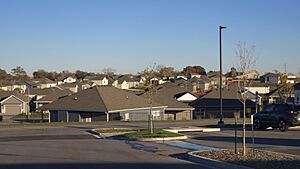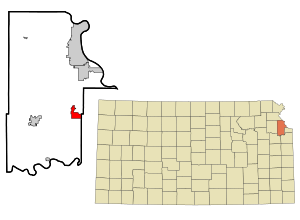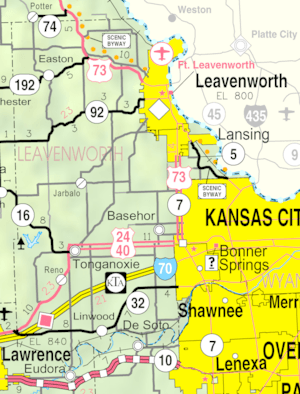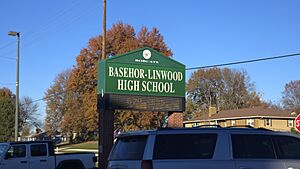Basehor, Kansas facts for kids
Quick facts for kids
Basehor, Kansas
|
|||
|---|---|---|---|

Basehor neighborhood as seen from City Hall (2024)
|
|||
|
|||

Location within Leavenworth County and Kansas
|
|||

|
|||
| Country | United States | ||
| State | Kansas | ||
| County | Leavenworth | ||
| Founded | 1889 | ||
| Incorporated | 1965 | ||
| Named for | Reuben and Ephraim Basehor (brothers) | ||
| Government | |||
| • Type | Mayor–Council | ||
| Area | |||
| • Total | 7.24 sq mi (18.74 km2) | ||
| • Land | 7.14 sq mi (18.50 km2) | ||
| • Water | 0.09 sq mi (0.24 km2) | ||
| Elevation | 984 ft (300 m) | ||
| Population
(2020)
|
|||
| • Total | 6,896 | ||
| • Density | 952.5/sq mi (367.98/km2) | ||
| Time zone | UTC-6 (CST) | ||
| • Summer (DST) | UTC-5 (CDT) | ||
| ZIP code |
66007
|
||
| Area code | 913 | ||
| GNIS ID | 2394073 | ||
Basehor is a city in Leavenworth County, Kansas, United States. It's part of the larger Kansas City metropolitan area. In 2020, about 6,896 people lived there. Basehor is known for its friendly community and growing schools.
Contents
History of Basehor
Early Land Ownership
The land where Basehor now stands was once part of a large area given to the Delaware Indians by the U.S. government. This happened on September 24, 1829, in exchange for their lands in Indiana. The Delaware people held onto this land until the 1860s.
Later, in 1866, the remaining Delaware lands were put up for sale. A railroad company, the Leavenworth, Pawnee, and Western Railroad Company, bought these lands in 1886.
The first private owners of the specific land for Basehor were Thomas Salem and Mary Z. Towne. They bought it from the railroad in 1873. They later sold 160 acres (0.65 km2) to Ephraim Basehor in 1874.
Founding the City
Basehor was founded in 1889 by two brothers, Reuben and Ephraim Basehor. They were from a group called Pennsylvania Dutch and moved to Kansas in 1854. Ephraim bought a farm and other land in the area.
When the railroad was finished in 1889, Ephraim decided to plan out a town on his land. He officially dedicated the town on November 30, 1889, and it was named after the Basehor family.
Developing Schools and Libraries
Ephraim Basehor gave land for the first schoolhouse around 1900. It was called Prairie Garden District #32. High school classes started in 1905, meeting above a local store.
In 1906, a new building was built for both high school and grade school students. It served students from kindergarten all the way through 12th grade.
Reuben Basehor donated $1,000 to build a library for the school. This concrete library building was later moved to the city park in 2016. A new brick high school was built in 1938 as a WPA project, which helped create jobs during the Great Depression.
A new grade school was built in 1955. By 1963, another new high school was constructed. The old high school building was then used for the top two grades of the grade school. In 2008, the community opened a new library on 158th Street.
Geography of Basehor
Basehor is a city that covers about 6.75 square miles (17.48 km2) of land. A very small part, about 0.07 square miles (0.18 km2), is covered by water.
Population and People
| Historical population | |||
|---|---|---|---|
| Census | Pop. | %± | |
| 1970 | 724 | — | |
| 1980 | 1,483 | 104.8% | |
| 1990 | 1,591 | 7.3% | |
| 2000 | 2,238 | 40.7% | |
| 2010 | 4,613 | 106.1% | |
| 2020 | 6,896 | 49.5% | |
| U.S. Decennial Census 2010-2020 |
|||
How Many People Live Here?
The population of Basehor has grown quite a bit over the years. In 1970, there were 724 people. By 2020, the population had grown to 6,896. This shows that more and more families are choosing to live in Basehor.
Who Lives in Basehor?
According to the 2020 census, most people in Basehor are white (about 87.67%). There are also African American, Native American, Asian, and people of two or more races living in the city. About 5.35% of the population is Hispanic or Latino.
Many households in Basehor have children under 18 (39%). Most families are married couples living together (63.9%). The average household has about 2.8 people. The average family has about 3.4 people.
The median age in Basehor in 2020 was 39.1 years old. This means half the population is younger than 39.1, and half is older. About 27.5% of the population is under 18, showing it's a city with many young people and families.
Education in Basehor
The Basehor–Linwood USD 458 public school district serves the community. Basehor is home to the Basehor–Linwood High School. The district's middle school is located on County Road 2 (158th Street).
The school district also has five elementary schools:
- Glenwood Ridge Elementary (across from the middle school)
- Basehor Elementary School
- Basehor Intermediate School
- Gray Hawk Elementary School
- Linwood Elementary School (located in Linwood)
See also
 In Spanish: Basehor para niños
In Spanish: Basehor para niños




